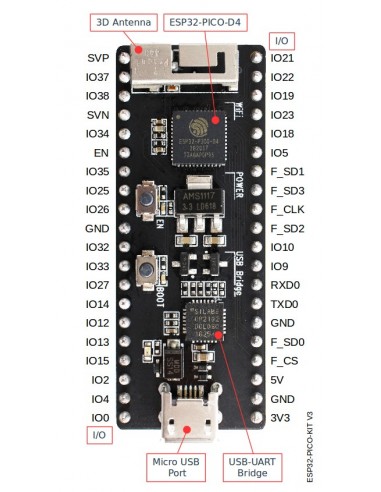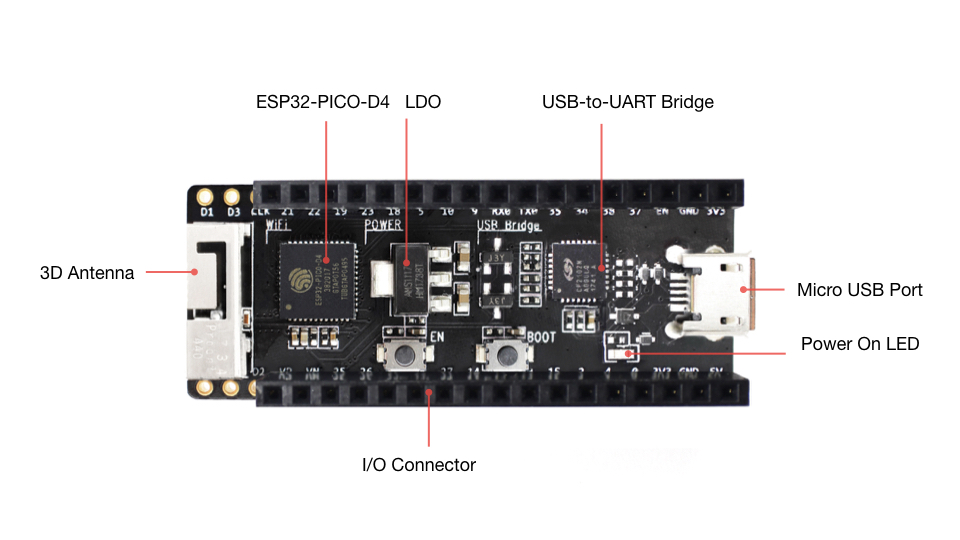









ESP32-PICO-KIT Dev. Board, V4.1
ESP32-PICO-KIT is an ESP32-based mini development board produced by Espressif.
The core of this board is ESP32-PICO-D4 - a System-in-Package (SiP) module with complete Wi-Fi and Bluetooth® functionalities. Compared to other ESP32 modules, ESP32-PICO-D4 integrates the following peripheral components in one single package, which otherwise would need to be installed separately:
40 MHz crystal oscillator
4 MB flash
Filter capacitors
RF matching links
This setup reduces the costs of additional external components as well as the cost of assembly and testing and also increases the overall usability of the product.
The development board features a USB-UART Bridge circuit which allows developers to connect the board to a computer's USB port for flashing and debugging.
All the IO signals and system power on ESP32-PICO-D4 are led out to two rows of 20 x 0.1" header pads on both sides of the development board for easy access. For compatibility with Dupont wires, 2 x 17 header pads are populated with two rows of male pin headers. The remaining 2 x 3 header pads beside the antenna are not populated. These pads may be populated later by the user if required.
Note
There are two versions of ESP32-PICO-KIT boards, respectively with male headers and female headers. In this guide, the male header version is taken as an example.
The 2 x 3 pads not populated with pin headers are connected to the flash memory embedded in the ESP32-PICO-D4 SiP module. For more details, see module's datasheet in Related Documents.
The block diagram below shows the main components of ESP32-PICO-KIT and their interconnections.

ESP32-PICO-KIT block diagram
The following figure and the table below describe the key components, interfaces, and controls of the ESP32-PICO-KIT board.

ESP32-PICO-KIT board layout (with female headers)
Below is the description of the items identified in the figure starting from the top left corner and going clockwise.
|
Key Component |
Description |
|---|---|
|
ESP32-PICO-D4 |
Standard ESP32-PICO-D4 module soldered to the ESP32-PICO-KIT board. The complete ESP32 system on a chip (ESP32 SoC) has been integrated into the SiP module, requiring only an external antenna with LC matching network, decoupling capacitors, and a pull-up resistor for EN signals to function properly. |
|
LDO |
5V-to-3.3V Low dropout voltage regulator (LDO). |
|
USB-UART bridge |
Single-chip USB-UART bridge: CP2102 in V4 provides up to 1 Mbps transfer rates and CP2102N in V4.1 offers up to 3 Mbps transfers rates. |
|
Micro USB Port |
USB interface. Power supply for the board as well as the communication interface between a computer and the board. |
|
5V Power On LED |
This red LED turns on when power is supplied to the board. For details, see the schematics in Related Documents. |
|
I/O |
All the pins on ESP32-PICO-D4 are broken out to pin headers. You can program ESP32 to enable multiple functions, such as PWM, ADC, DAC, I2C, I2S, SPI, etc. For details, please see Section Pin Descriptions. |
|
BOOT Button |
Download button. Holding down Boot and then pressing EN initiates Firmware Download mode for downloading firmware through the serial port. |
|
EN Button |
Reset button. |
You might also like